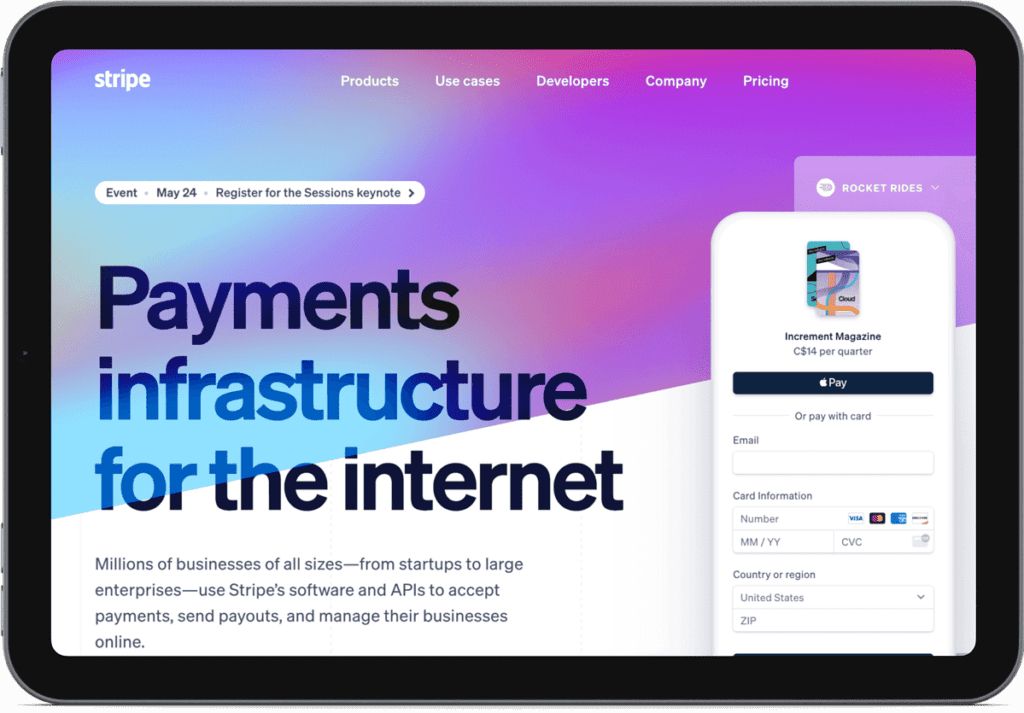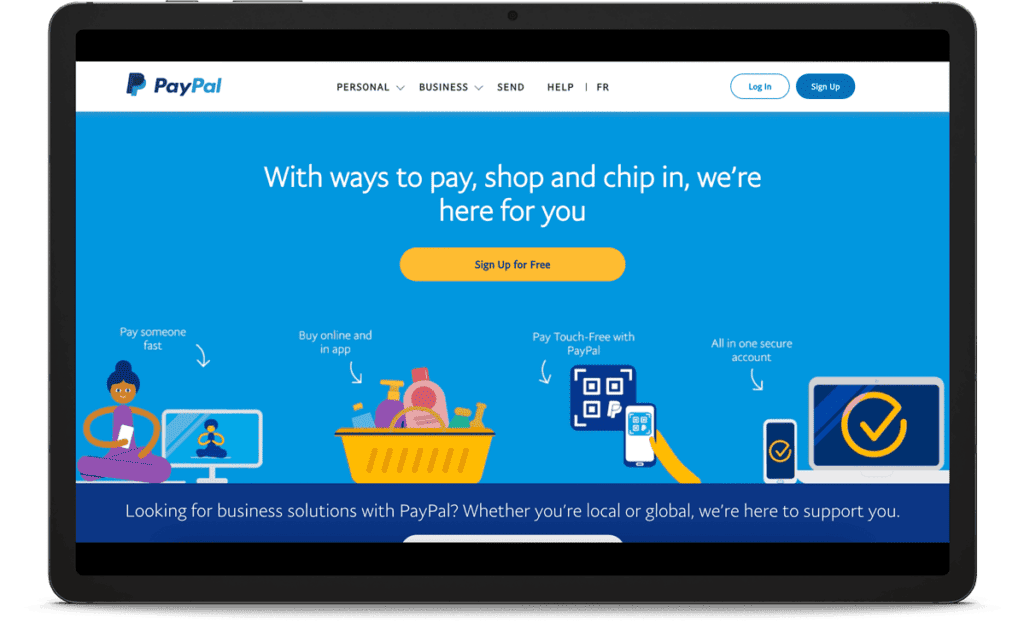When it comes to payment processors, there are a lot of options to choose from when you want to accept payments electronically. And if you’re like most business owners, you want to make sure you’re making the best decision possible for your company.
There are tons of online payment gateways out there that also offer options for in person transactions, such as Google Pay and Apple Pay.
However, in this blog post and the above video, we’ll take a look at Stripe vs PayPal – two of the most popular payment processors around.
We’ll look at the fees each one charges, how easy it is to collect payments, developer-friendliness, and whether or not they offer recurring billing, among other factors.
All so that you can make an informed decision about which one is right for your business!
What makes a good payment processor?
When you’re looking for a payment processor, there are a few key factors to keep in mind.
First, you’ll want to consider the fees charged by the service provider. Would you prefer a processor that charges low fees, or would you be okay with something that takes a bit more?
Second, you’ll want to think about the developer friendliness of your chosen payment processing service…
Are you looking for something that’s easy to integrate into your existing website or app?
Or are you willing to put in a little extra work to get started?
Finally, you’ll want to consider whether or not the processor offers recurring payments. This is important for those who are looking to set up recurring subscriptions or membership-based businesses.
Some context…
Stripe
Stripe is a popular payment processing company that has been around since 2010.
The company is headquartered in San Francisco, CA and has a reputation for being easy to use and developer-friendly.
The fees for using Stripe are fairly low, and they offer recurring payments.

PayPal
PayPal is a payment processing and financial technology company that has been around for a long time.
People link their bank accounts, debit cards, or credit cards to their PayPal account and pay through it.

The company is headquartered in San Jose, CA. PayPal is easy to use and offers a lot of features, such as recurring payments.
However, the fees can be high if you’re processing a lot of transactions.
What’s a recurring payment?
A recurring payment is a type of subscription where your customers are automatically charged on a regular basis—typically monthly or yearly.
This is different from a one-time payment, where your customer would only be charged once for a product or service.
Why offer recurring payments?
Whether you’re running membership courses, subscription box services, or magazine subscriptions with a monthly fee, recurring, regularly scheduled payments can be a great way to increase revenue as they allow for more predictable streams of revenue than variable payments and increase customer lifetime value for those who subscribe to these payments, due to customer retention.
They can also help you better budget and forecast your business’s future earnings.
So, which is better for YOU – Stripe vs PayPal?
It really depends on your individual needs and preferences.
Both Stripe and PayPal collect payments and offer payment processing through bank accounts, credit card processing, and debit card transactions.
Both payment processing platforms allow you to send a paid invoice for each order; you can even set up recurring invoices to go along with recurring payments via Stripe billing or PayPal invoicing.
The type of business you’re running will have an impact on the tool that works best for you.
What do you need?
For PayPal, you’ll need to set up a PayPal Business or merchant account while Stripe acts as a merchant account, payment processor, and gateway. A merchant account allows you to accept and process payments. This is a must, as you want to be able to collect when a customer pays.
In addition to payment processing, PayPal offers a little more. If you’re running a business where you’re shipping out physical goods, PayPal offers the ability to print out shipping labels, pre-paid postage, and all of that good stuff.
On the other hand, Stripe was designed to offer customization of the payment processing experience. You can set up recurring payments, subscription plans, and pretty much anything else you can dream up.
Although both offer options like automated recurring payments, PayPal is a bit less flexible.
Control over payment plans
With Stripe, you can manage everything through something like AccessAlly—you have control. Once payment is made through PayPal, you have almost no control as PayPal manages things automatically.
However, PayPal is great for smaller one-time payments as opposed to fixed recurring payments; subscriptions are a bit tricky with this payment service provider.
PayPal customers can cancel automatic payments or recurring subscriptions on their account, so once customers authorize a cancellation on their end, it can be difficult to collect missed payments or failed payments.
Fees
When it comes to online transaction fees, Stripe is the clear winner. PayPal has a lot of different fee structures, depending on the type of transaction, and they’re all a little complicated.
Stripe’s integrated transaction fee comes in at 2.9% plus 30 cents per transaction. It does not charge a monthly fee. There are also customized options for things like international transactions and volume discounts.

PayPal has a range of transaction fees depending on your account type and the number of complete transactions you receive. Thus, the transaction fee can range from 2.59% to 3.49%, plus 49 cents per transaction.
Most people will end up spending more on PayPal, which makes Stripe a better option when you pay fees for PayPal transactions versus Stripe ones.
However, it’s important to note that both processors will keep the transaction fees if someone is refunded, so you may lose a bit there. However, they aren’t the only payment processors that have this practice.
You Might Change Your Mind About What Features You Want, so You Need a Platform That’s Flexible.
Get your own free demo sandbox account so you can experience the flexibility AccessAlly has to offer.

Accessing your funds
For Stripe, you can access your funds easily as your income can be auto-deposited to your bank accounts on a regular schedule.
PayPal has a similar system where you receive your funds immediately, and they’re deposited into your digital wallet or PayPal balance in your PayPal account.
If you wanted to purchase something using PayPal, you could use the money immediately using this PayPal cash.
However, to get this money into your bank account, you need to manually transfer it between the platforms which can take a day or two—and to automate it, PayPal charges a 1.5% fee to do that.
Brand loyalty and reputation
These factors are important to consider when you’re choosing a payment processor.
PayPal has been around for longer, so some people are more familiar and are trusting of the PayPal brand.
In international places where someone might not be able to make debit card payments or credit card payments due to incompatibility with Stripe, PayPal has an advantage.
The fact that people can make PayPal payments by logging into their account and not giving their credit card details offers more security.
When it comes to payment disputes and fraudulent transactions, PayPal tends to side with the customer; this improves trust in this payment processor.
Stripe is newer on the scene but it’s growing in popularity—especially with developers—because of its easy-to-use API.
If you don’t want to feel like you’re promoting PayPal on your website (as their logo will show up), Stripe is an excellent option as it’s transparent—customers don’t know that they’re paying on Stripe as they just input their details to purchase.
Currencies
With both Stripe and Paypal, your online business can take payments in multiple currencies. If you have an international customer base, then this is a key factor in choosing your payment processor.
Stripe currently supports 135+ currencies, while PayPal supports 26. So if you want to offer more currency options to your customers, Stripe would be the better option.
Types of payment
Stripe has the upper hand in this category, as it offers many different types of payment. In different locations, people may prefer to choose Apple Pay, Google Pay, Microsoft Pay, debit cards, or other local ways of paying.
Integration with Stripe vs PayPal
With PayPal, you can just put some code on your website and accept payments quickly. However, this isn’t the most practical as you might want something to take orders such as a checkout system.
For this, you need an eCommerce platform such as Shopify that is integrated with PayPal. If you want more control over the design of your checkout system, Stripe is a good option.
For Stripe, you can use their built-in forms to process payments and orders. Like with PayPal, a system like SamCart or AccessAlly will help you deliver your goods to the customer.
Integration with AccessAlly
There are benefits to having a checkout process through AccessAlly. Customers choose to pay either by Stripe or PayPal—with Stripe, they’ll just enter their payment details and payment information.
When their purchase is complete and account details are entered, customers are automatically taken into a members area, where they receive a welcome and can begin diving into what they’ve paid for.
A system like AccessAlly is handy if you want to accept payments, manage payment information, set up fixed recurring payments, have automatic payments, and waive monthly fees for a free trial, among many other options.
Self-management options through a customer’s account are important for customer relationship management, especially since it allows members to update their information, look at existing payments and recurring invoices, and feel a sense of autonomy.


Flexibility
As previously mentioned, Stripe is the more flexible payment gateway as it offers flexibility that PayPal does not, such as pausing automated payments, granting credits to customers, adjusting a billing cycle, and changing pricing.
Stripe is better for the online payment processing of recurring payments and installment plans.
Stripe vs PayPal: Which is better for you?
It depends on your business model and needs.
For example, if you are a recurring subscription service with recurring billing, then Stripe is the better option as it offers more flexibility for recurring payments. If you’re looking for something with a well-built reputation, you may want to accept PayPal transactions.

What has your experience been with Stripe and PayPal? Leave a comment and let us know!




